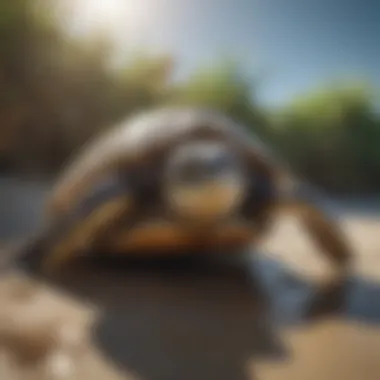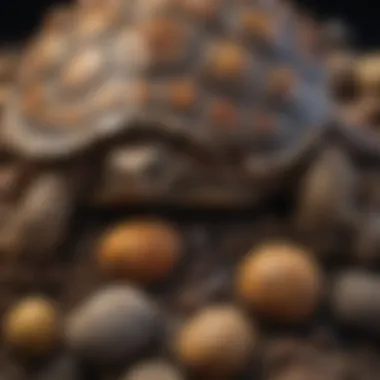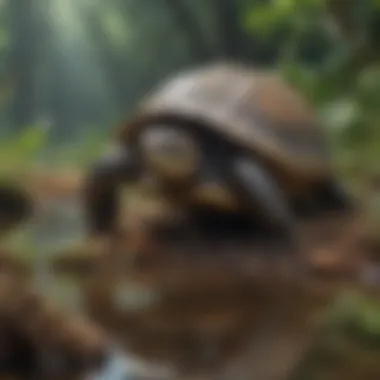Unveiling the Intriguing Realm of Turtle Excrement: An In-Depth Exploration


Rock and Fossil Identification
Turtle poop may seem like a mundane topic at first glance, but delving deeper reveals an intricate world of ecological significance. Just like identifying different types of rocks and fossils, understanding the various aspects of turtle excrement is crucial in appreciating its role in the ecosystem. Characteristics such as size, shape, and coloration can provide valuable insights into the turtle species and its diet. Tools such as binoculars for observing turtle behavior in their natural habitat can offer clues to the types of rocks they might ingest.
Importance of Turtle Poop
The importance of turtle poop in the ecosystem cannot be overstated. While rocks and fossils offer glimpses into Earth's history, turtle poop serves as a real-time indicator of environmental health. By studying turtle excrement, researchers can determine the quality of water bodies and the impact of pollution on aquatic life. Just as identifying key patterns in rocks leads to geological discoveries, analyzing turtle feces can unveil critical information about biodiversity and habitat health.
Ecological Impact of Turtle Poop
Similar to how geological formations shape landscapes, turtle dung plays a significant role in nutrient cycling. As herbivores, turtles consume vegetation rich in nutrients. Through digestion and excretion, they release essential elements like nitrogen and phosphorus back into the ecosystem. This process not only fertilizes soil but also sustains plant growth, ultimately supporting a diverse range of organisms in the ecosystem. Moreover, the decomposition of turtle poop contributes to soil health, paralleling the transformative impact of geological processes over time.
Conclusion
Introduction
In the vast expanse of the natural world, seemingly mundane aspects often hold significant importance. The enigmatic realm of turtle poop, albeit unconventional, plays a vital role in maintaining ecological harmony and fostering sustainability. This article embarks on a journey to unravel the mysteries surrounding turtle excrement, shedding light on its intricate relevance within ecosystems. By delving into the depths of this lesser-explored subject, readers will gain a profound understanding of the crucial role that turtle waste plays in the delicate balance of nature.
Unveiling the Mystery
The Significance of Turtle Poop
Delving into the world of turtle droppings unveils a realm of environmental significance that may go unnoticed by many. The pivotal role of turtle feces lies in its contribution to nutrient cycling within ecosystems. As these slow-moving creatures traverse their habitats, they leave behind a rich source of organic matter that serves as a foundation for sustaining diverse forms of life. The unique characteristic of turtle excrement lies in its ability to enrich the soil and support a myriad of plant species, ultimately fostering a flourishing environment.
Diverse Turtle Species and Their Excrement
The juxtaposition of diverse turtle species alongside their distinct excrement brings forth a fascinating exploration of ecological interactions. Each turtle species contributes its own unique blend of nutrients and microbial flora to the environment through their waste. This diversity in excrement composition influences the surrounding ecosystem in multifaceted ways, showcasing the intricate web of connections that underlie the natural world. Understanding the nuances of these different excreta profiles is fundamental to grasping the broader implications of turtle waste in ecological systems.
Ecological Impact
Nutrient Cycling in Ecosystems
Nutrient cycling, propelled by the deposition of turtle waste, forms the cornerstone of ecological balance within habitats. The continuous breakdown and decomposition of turtle excrement release essential nutrients that fuel the growth of vegetation, thereby perpetuating the cycle of life. This process not only sustains the flora within a given ecosystem but also supports a cascade of interactions among various organisms, illustrating the interconnectedness of biological communities.


Role of Turtle Waste in Soil Fertility
The intricate relationship between turtle waste and soil fertility underscores the essential role that excrement plays in nurturing terrestrial ecosystems. As turtle poop decomposes, essential nutrients like nitrogen and phosphorus are gradually released into the soil, enhancing its fertility. This nutrient enrichment facilitates robust plant growth, contributing to the overall health and resilience of the ecosystem. By examining the fundamental link between turtle waste and soil fertility, a deeper comprehension of the symbiotic dynamics at play in nature emerges.
Research Insights
Studies on Turtle Scat Composition
In-depth studies focusing on the composition of turtle scat offer illuminating insights into the intricate world of excrement analysis. By dissecting the components of turtle waste, researchers unveil valuable information regarding nutrient content, microbial diversity, and ecological implications. These studies provide a solid foundation for understanding the broader ecological implications of turtle feces, paving the way for informed conservation strategies and sustainable ecosystem management.
Implications for Wildlife Conservation
The implications of turtle waste extend far beyond ecological dynamics, encompassing critical implications for wildlife conservation efforts. By recognizing the role of turtle excrement in supporting biodiversity and ecosystem stability, conservationists can leverage this knowledge to formulate targeted conservation initiatives. Understanding how turtle poop influences the natural world allows for more holistic approaches to wildlife preservation and habitat conservation, highlighting the intricate interplay between seemingly modest ecological elements and overarching conservation objectives.
Composition and Characteristics
In this article focusing on the fascinating world of turtle poop, the section of Composition and Characteristics plays a pivotal role in unraveling the intricate details of turtle excrement. Understanding the composition and characteristics of turtle droppings is crucial in shedding light on the ecological significance and implications of these waste products. By delving into the texture, consistency, odor profile, and color variations of turtle poop, readers will be able to grasp the essence of how these factors contribute to the overall topic of environmental sustainability.
Analyzing Turtle Droppings
Texture and Consistency
Texture and consistency are key aspects that define turtle droppings and offer valuable insights into the overall nature of turtle excrement. The unique texture and consistency of turtle poop not only reflect the diet and health of the turtle but also influence nutrient cycling within ecosystems. By examining the firmness, moisture content, and overall structure of turtle droppings, researchers can glean essential information about the turtle's digestive processes and its role in nutrient recycling. The texture and consistency of turtle poop serve as indicators of the turtle's overall well-being and ecosystem interactions, making them a crucial element in understanding the broader ecological context.
Odor Profile
The odor profile of turtle excrement is another intriguing aspect that contributes to the overall perception and ecological impact of turtle waste. The distinct smell of turtle poop is a result of the breakdown of ingested materials within the turtle's digestive system, which releases volatile compounds responsible for its characteristic odor. Understanding the odor profile of turtle droppings not only provides crucial information about the turtle's diet and digestive processes but also highlights the role of scent in attracting or repelling other organisms within the ecosystem. By exploring the nuances of the odor profile, researchers can gain a deeper appreciation for the complexity of turtle waste and its interconnectedness with the environment.
Color Variations
Color variations in turtle poop offer valuable insights into the influence of diet on excrement coloration and the significance of color changes in understanding turtle physiology. The color of turtle droppings can vary based on the types of food consumed, with different pigments from plant or animal matter affecting the hue of the excrement. By investigating the influence of diet on excrement coloration, researchers can draw connections between turtle foraging behavior and the subsequent effects on nutrient cycling and ecosystem dynamics. Moreover, understanding the significance of color changes in turtle poop can provide essential information about the turtle's health status, stress levels, and environmental adaptations. The color variations in turtle droppings present a visually engaging aspect that not only adds depth to the study of turtle excrement but also offers practical insights into monitoring turtle populations and supporting conservation efforts.
Influence of Diet on Excrement Coloration
The influence of diet on excrement coloration is a critical factor to consider when analyzing turtle droppings, as it provides a direct link between food intake and waste output. By examining how different dietary components impact the color of turtle poop, researchers can infer valuable information about the nutritional quality of the turtle's diet and the availability of specific nutrients in its environment. Understanding the influence of diet on excrement coloration not only helps in interpreting feeding behavior and resource utilization patterns but also aids in assessing the overall health and physiological condition of turtle populations. The coloration of turtle droppings serves as a visual indicator of the intricate relationships between diet, metabolism, and ecosystem dynamics, underscoring the importance of considering color variations in ecological studies and conservation practices.


Significance of Color Changes
The significance of color changes in turtle poop holds notable implications for monitoring and managing turtle populations, as variations in excrement color can reflect underlying health issues or environmental stressors. By investigating the factors that contribute to color changes in turtle droppings, researchers can monitor population trends, assess habitat quality, and detect potential threats to turtle species. The ability to recognize and interpret color changes in turtle poop provides valuable information about the welfare of these reptiles and aids in formulating targeted conservation strategies that align with the specific needs of vulnerable turtle populations. The significance of color changes in turtle excrement goes beyond visual aesthetics, serving as a practical tool for conservation biologists, wildlife managers, and researchers striving to safeguard turtle species and their habitats.
Environmental Implications
In the vast landscape of environmental science, the implications surrounding turtle excrement hold a unique significance that reverberates through ecosystems. Through a meticulous examination of the ecological impacts, it becomes evident that turtle poop plays an integral role in maintaining the delicate balance of nature. Focusing on the specific aspects of nutrient cycling in ecosystems and the essentiality of turtle waste in soil fertility, this section sheds light on the intricate connections between these biological processes and the sustainability of our environment. The interplay between turtles and their excrement showcases a remarkable symbiosis that underscores the importance of these creatures in preserving the ecological harmony.
Fertilization Properties
Nutrient Enrichment in Soil
Delving deeper into the realm of nutrient enrichment in soil facilitated by turtle excrement, it becomes apparent that this process is paramount for bolstering the health and vitality of terrestrial ecosystems. The unique characteristic of turtle waste lies in its ability to enrich the soil with a diverse array of essential nutrients that act as a catalyst for robust plant growth. The distinct advantage of nutrient enrichment in soil through turtle scat lies in its organic and sustainable nature, offering a natural alternative to conventional fertilizers. This nutrient-rich composition not only benefits the soil structure but also promotes a thriving ecosystem, making it a highly sought-after choice for environmental sustainability initiatives.
Impact on Plant Growth
The impact of turtle excrement on plant growth is a vital component of the intricate web of ecological interactions. By enhancing the soil's fertility and providing crucial nutrients to plant life, turtle waste serves as a potent stimulant for botanical flourishing. The key characteristic of this impact lies in its ability to support a diverse range of plant species, fostering biodiversity and resilience within the ecosystem. A unique feature of the excrement's impact on plant growth is its ability to spur vegetative development while minimizing the reliance on synthetic fertilizers. While the advantages of this process are abundant, it is essential to consider potential drawbacks such as nutrient imbalance in cases of excessive deposition, emphasizing the need for balanced environmental stewardship.
Microbial Interactions
Role of Gut Microbiota in Excrement
Unpacking the role of gut microbiota in turtle excrement unveils a fascinating dimension of microbial interactions within the natural world. The key characteristic of these microbiota lies in their crucial contribution to the decomposition and transformation of ingested materials, shaping the composition of turtle waste. This symbiotic relationship between turtles and their gut microbiota highlights the intricate interplay between host and microorganisms, showcasing a beneficial symbiosis for nutrient cycling in ecosystems. The unique feature of this microbial interaction is its role in enhancing nutrient availability for soil processes, consolidating the vital connection between turtle excrement and ecosystem health.
Decomposition Processes
Exploring the decomposition processes initiated by turtle excrement brings to light the essential role played by microbial communities in nutrient recycling. The key characteristic of these processes is their ability to break down complex organic matter, releasing essential nutrients that fuel terrestrial productivity. The beneficial nature of decomposition processes lies in their role in soil rejuvenation and fertility enhancement, supporting plant growth and ecosystem resilience. A unique feature of these processes is their contribution to carbon sequestration and energy transfer within the ecosystem, reflecting a comprehensive understanding of the ecological services provided by turtle excrement. While the advantages of decomposition processes are commendable, potential disadvantages may include imbalances in microbial populations, underscoring the delicate equilibrium required for sustainable waste management strategies.
Conservation Considerations
In this section of the article, we delve into the critical aspect of Conservation Considerations, which holds immense significance in maintaining the delicate ecological balance concerning turtle populations and their habitats. Conservation Considerations play a pivotal role in safeguarding the sustainability of turtle species and their surrounding environments. By implementing strategies focused on habitat protection, species conservation, and ecosystem restoration, conservation efforts aim to ensure the long-term viability of turtle populations while fostering biodiversity and ecosystem resilience. Through a holistic approach encompassing research, public awareness, policy advocacy, and habitat restoration, Conservation Considerations serve as pillars for promoting environmental stewardship and preserving the intricate web of life.
Ecosystem Balance


Conserving Turtle Populations:
Within the realm of Conservation Considerations, the conservation of turtle populations stands out as a fundamental aspect instrumental in maintaining ecosystem balance. By safeguarding turtle species from threats such as habitat loss, pollution, and illegal trade, the conservation of turtle populations contributes significantly to the overall health and diversity of ecosystems. Conserving turtle populations not only ensures the survival of these unique reptiles but also benefits other species that depend on turtles for ecosystem services. The strategic protection of turtle populations through measures such as habitat preservation, population monitoring, and anti-poaching initiatives is a crucial step in fostering ecological equilibrium and biodiversity conservation.
Preserving Habitat Integrity:
Another crucial component of Conservation Considerations is the preservation of habitat integrity, which plays a vital role in sustaining healthy turtle populations and their ecosystems. Preserving the integrity of turtle habitats involves maintaining natural landscapes, reducing anthropogenic disturbances, and mitigating habitat degradation. By safeguarding essential nesting sites, foraging grounds, and migration routes, habitat integrity preservation supports the resilience and adaptability of turtle species to environmental changes. Upholding habitat integrity not only benefits turtles but also contributes to the overall health of ecosystems by conserving biodiversity, mitigating climate change impacts, and enhancing habitat connectivity.
Regulatory Aspects
Laws Protecting Endangered Turtles:
In the realm of regulatory aspects within Conservation Considerations, laws protecting endangered turtles play a crucial role in safeguarding vulnerable turtle species facing threats of extinction. Legislation aimed at conserving endangered turtles encompasses measures such as habitat protection, trade restrictions, conservation programs, and enforcement mechanisms to ensure the survival and recovery of imperiled species. By establishing legal frameworks to combat poaching, trafficking, and habitat destruction, laws protecting endangered turtles serve as essential tools in preserving biodiversity, upholding ecosystem balance, and promoting sustainable resource management.
Impact of Human Activities:
Addressing the impact of human activities on turtle populations is another key regulatory aspect within Conservation Considerations. Human activities such as urban development, pollution, climate change, and recreational activities can pose significant threats to turtle habitats and populations. Understanding and mitigating the adverse effects of human activities on turtles require proactive conservation measures, stakeholder engagement, and sustainable development practices. By promoting responsible environmental stewardship, conservation education, and community participation, strategies aimed at mitigating the impact of human activities play a crucial role in protecting turtles, conserving biodiversity, and fostering harmonious coexistence between humans and wildlife.
Future Research Directions
In this article, delving into the intriguing topic of turtle poop, exploring future research directions is paramount to advancing scientific knowledge and fostering environmental sustainability. By focusing on the specific elements within this realm, we can uncover innovative ways to study and utilize turtle waste for the betterment of ecosystems. Identifying gaps in current understanding and envisioning novel approaches are crucial steps in steering conservation efforts.
Advancing Scientific Knowledge
Innovations in Waste Analysis
Investigating innovations in waste analysis within the context of turtle excrement opens a new avenue for researchers to explore the composition and impact of these biological remnants. The key characteristic of innovations in waste analysis lies in its ability to provide precise and detailed insights into the types of nutrients present in turtle scat. This method facilitates a deeper understanding of the ecological role of turtle waste and aids in formulating targeted conservation strategies. Despite certain limitations, such as the need for specialized equipment and expertise, innovations in waste analysis stand out as a valuable tool for dissecting the complexities of turtle excreta.
Long-term Ecological Studies
Venturing into long-term ecological studies unveils the dynamics and interconnectedness of diverse ecosystems influenced by turtle waste. The key characteristic of such studies is their ability to track the lasting effects of turtle excrement on soil fertility, plant growth, and microbial interactions. This prolonged observation period offers a comprehensive view of how turtle scat shapes the environmental landscape over time. While conducting long-term ecological studies can be resource-intensive, the depth of insight gained outweighs the challenges, positioning it as an indispensable method for illuminating the broader implications of turtle waste.
Technological Applications
Bioengineering Solutions
Exploring bioengineering solutions in the context of turtle poop holds promise for harnessing nature's mechanisms to address environmental challenges. The key characteristic of bioengineering solutions is their ability to mimic natural processes in optimizing the nutrient cycling brought about by turtle excrement. This approach offers a sustainable and eco-friendly method for enhancing soil fertility and promoting plant health. While bioengineering solutions require careful calibration and monitoring, their potential benefits in ecological restoration make them a compelling choice for integrating technology with environmental conservation.
Bioremediation Strategies
Diving into bioremediation strategies offers a glimpse into how biological organisms can aid in mitigating environmental pollution caused by turtle waste. The key characteristic of bioremediation strategies lies in their ability to utilize microbes and plants to break down pollutants present in areas impacted by turtle scat. This method presents a natural and cost-effective approach to restore habitats affected by nutrient imbalances. Although the application of bioremediation strategies requires a tailored approach for each ecosystem, their adaptive nature and sustainable outcomes make them a valuable addition to conservation practices.







